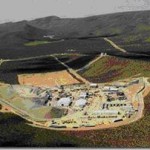Archive
- January (27)
- February (25)
- March (28)
- April (29)
- May (27)
- June (26)
- July (23)
- August (23)
- September (22)
- October (21)
- November (21)
- December (22)
U.S. Spent Nuclear Fuel Policy: Road to Nowhere [Part V: Lessons]
By Robert Peltier -- July 13, 2010Part 1 of this series explored the historical context of the U.S. nuclear waste storage policy. Part II and Part III looked at the failed Salt Vault and Yucca Mountain projects, respectively. Part IV reviewed the legal and political fallout from the Yucca Mountain failure. In this final post, we review the past failed attempts to reprocess nuclear fuel in the U.S. and examine the global state-of-the-art reprocessing plants now operating or under construction.
Reprocessing and Recycling in the U.S.
The reprocessing of nuclear fuel first began in the U.S. in January 1943. The Bismuth Phosphate Precipitation Process was used for recovering macroscopic quantities of plutonium. The REDuction-OXidation (REDOX) process was the first successful solvent extraction process to recover both uranium and plutonium; it was further refined into the Plutonium and URanium EXtraction (PUREX) process, which has become the most common and fully commercialized liquid-liquid extraction process for the treatment of spent nuclear fuel (SNF).…
U.S. Spent Nuclear Fuel Policy: Road to Nowhere [Part IV: Picking Up the Pieces]
By Robert Peltier -- July 12, 2010Part I of this series reviewed the historical context of the U.S. nuclear waste storage policy. Part II and Part III historically reviewed the ill-fated Salt Vault and Yucca Mountain projects, respectively. This post reviews the legal and political fallout from the Yucca Mountain failure, and Part V tomorrow will explore failed attempts to reprocess nuclear fuel in the U.S. and examine the global state-of-the-art reprocessing plants now operating or under construction.
Ratepayers Pay to (Not) Play

1. View of the above-ground support structures and north and south portals at the now-defunct Yucca Mountain repository. Source: Department of Energy/Office of Civilian Radioactive Waste Management (DOE/OCRWM)
The nuclear industry is unique among energy producers in its contractual commitment to cover the full costs for managing its waste. The Nuclear Waste Policy Act (NWPA) of 1982 directed utilities to levy fees on electricity generated by nuclear power and to pay those fees into a federal Nuclear Waste Fund (NWF) that was to be used to develop and operate a national repository.…
The U.S. Spent Nuclear Fuel Policy: Road to Nowhere [Part III: Yucca Mountain]
By Robert Peltier -- July 10, 2010Part I explored the historical context of the U.S. nuclear waste storage policy, while Part II reviewed the 1960s Salt Vault project.
This post looks at the legislative history of the ill-fated Yucca Mountain repository and the formation of a committee to explore alternative storage sites (again). In Part IV, we will look at some of the legal and political repercussions of Yucca Mountain’s failure. Finally, in Part V, we explore failed attempts to reprocess nuclear fuel in the U.S. and examine the global state-of-the-art reprocessing plants now operating or under construction.
The Retrievable Surface Storage Facility
The AEC announced plans (circa May/June 1972) to construct an engineered, at-grade Retrievable Surface Storage Facility (RSSF) to be used until a permanent geological repository would be available. The plan was to locate the RSSF at an AEC or federal site in the western U.S.…